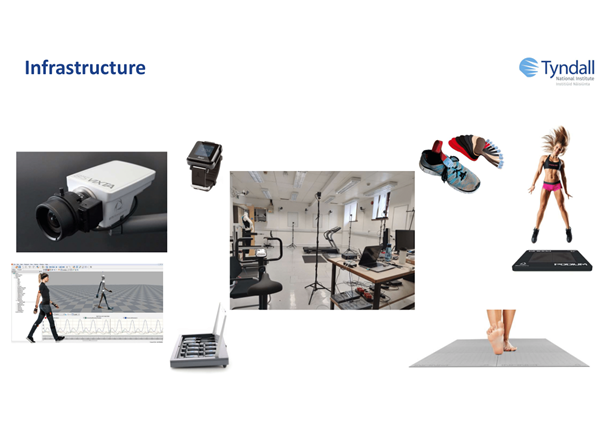Biomechanics, Motion Analysis, Physiology
About
Human Biomechanics is an intriguing discipline that bridges biology and physics, examining human body movement and function through mechanical physics principles. This approach helps researchers unravel the complexity of human motion and understand the roles of force, torque, and equilibrium in controlling daily activities. It is a vital area of study in sports science, medicine, ergonomics, and engineering. The equipment in this lab offers practical experience with various biomechanical tools essential for analysing human movement.
Description
Human Biomechanics is an intriguing discipline that bridges biology and physics, examining human body movement and function through mechanical physics principles. This approach helps researchers unravel the complexity of human motion and understand the roles of force, torque, and equilibrium in controlling daily activities. It is a vital area of study in sports science, medicine, ergonomics, and engineering, providing critical insights that can improve performance, prevent injuries, and enhance overall well-being.
The equipment in our lab offers extensive practical experience with various biomechanical tools essential for analyzing human movement. Our full-body motion capture system, OptiTrack, equipped with 12 cameras, enables precise tracking of body movements in three-dimensional space. The Movella inertial motion capture system complements this by offering a portable solution for motion analysis in real-world environments. These advanced systems allow for detailed study of joint angles, segment orientations, and overall kinematics, providing invaluable data for research and application in diverse fields.
Additionally, our lab is outfitted with a range of tools to measure and analyze different aspects of physical activity and body mechanics. The force platform, pressure mat, and pressure insoles provide insights into ground reaction forces and pressure distribution during various activities, essential for understanding balance and gait. Acoustic emission sensors, sEMG, Empatica E4, ActiGraph, and EEG facilitate the monitoring of muscle activity, physiological responses, and brain activity. This comprehensive suite of tools ensures a holistic approach to biomechanics, enabling researchers to gain a thorough understanding of human movement from multiple perspectives.
Technical specifications:
- Full-body motion capture system OptiTrack (12 cameras)
- Inertial motion capture system MTw Awinda Movella (17 sensors with 9 DOF)
- 3D Force platform PODIUM (BTS Bioengineering)
- Pressure mat P-Walk (BTS Bioengineering)
- Pressure insoles 3 sizes (Novel)
- Acoustic emission sensors (MISTRAS Group)
- Wireless surface electromyography (EMG) 20 sensors (FREEEMG BTS Bioengineering)
- Empatica E4 wristband (PPG, accelerometer, GSR)
- ActiGraph / ActivPAL / Axivity (accelerometers)
- Wireless Electroencephalogram (EEG)
Case study:
The equipment can be used in generally two contexts.
In the first one the end-user has developed a new sensor/system which is related to human motion or physiology (for instance a sweat sensor, or a system used for diagnosis of Parkinson’s disease) and the end-user is interested in characterizing and validated those developed prototypes against gold-standard technologies.
In the second context, the end-user is interested in collecting data related to human motion or physiology (in multiple applications, such as rehabilitation, stroke, Parkinson’s, sport injuries, etc.) for performing data analytics tasks, which therefore require data collections to be performed with gold-standard technologies.
Optional:
Examples of publications which adopted the available lab equipment:
10.1109/ACCESS.2022.3204969
https://doi.org/10.3390/s22239027
10.1109/ACCESS.2024.3361754
https://doi.org/10.1038/s41597-024-03254-8
https://doi.org/10.1016/j.humov.2024.103200
10.1109/ACCESS.2024.3375871
Examples of projects which adopted this equipment:
Wearable Sensors for Mental Health
This project explored the adoption of wearable sensors in the psychiatry domain for the evaluation of physical activity and sleep in young subjects with mental health conditions undergoing interventions.
CONFIRM – SFI Research Centre for Smart Manufacturing
The research funded by the SFI Research Centre for Smart Manufacturing culminated in a series of projects exploring the adoption of wearable sensors and machine learning models for fatigue detection in workers involved in industry 4.0 settings.
Biomechanical Assessment of Ostomy Bags
This project investigated the kinematics of ostomy pouches during activities of daily living that will enable the development of a bench test rig to accurate replicate torso movements and skin deformation in absence of human participants.
SFI Centre for Research Training in Artificial Intelligence
The research funded by the SFI Centre for Research Training in Artificial Intelligence culminated in a project investigating the adoption of wearable sensors and AI for the management of chronic migraine.
Precision Diagnosis via Wearable Motion Detection Sensors
This project investigated the development of a wearable system for the objective assessment of Parkinsonians’ symptoms and physiological monitoring via wearable sensors and machine learning models.
HOLISTIC – Holistic Human Sensing for Health and Wellness
This project investigated the development of a holistic solution for the remote evaluation of hamstring injuries in sport athletes via wearable EMG-based smart garments.
Insight – SFI Research Centre for Data Analytics
The research funded by the SFI Research Centre for Data Analytics culminated in a series of projects exploring the adoption of wearable sensors and machine learning models for rehabilitation, orthopedics, and biomechanics.
Smart sENsor Devices fOr rehabilitation and Connected health (SENDoc)
This project investigated the use of wearable sensor systems in ageing communities living in sparsely populated areas. Targeted use cases included Parkinson’s disease monitoring, fall prediction, mortality prediction, and home rehabilitation.
Estimation of Ground Reaction Forces in Athletes via Wearable Systems
This project explored the development of a wearable solution for the accurate estimation of ground reaction forces in athletes during running via machine learning and biomechanics models.
Smart Knee System for at-Home Rehabilitation (SKYRE)
This project explored the development of a multi-sensor wearable solution for the real-time motor assessment of lower-limbs during rehabilitation in subjects following ACL reconstruction, leveraging a mobile application for enhancing patients’ compliance and motivation.
Access Provider / Facilities




